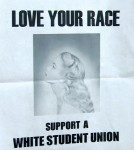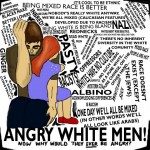Continued reading from Who’s White?, by John Law at Stormfront.
If someone were to say that they were 12.5% Amerindian then, as far as we’re concerned, that’s what they are, 1/8th non-White. This is something about which we can’t compromise. You’re either White or you aren’t.
After all, on an anonymous message board, we don’t have the person-to person contact that we do in the real world. We don’t have the visual clues, the body language, the vocal expressions, the facial expressions, the overall impressions that we can get in real person-to-person meetings. In personal encounters if someone looks White, sounds White, acts White, says they’re White, then we can pretty much assume they’re White. But on an anonymous message board we don’t have those visual and auditory clues. A poster can post a picture of anybody at all and claim to be that person but unless we have met that poster in person, we don’t know who they are. On an anonymous message board all we have is what a poster writes and if he writes that he is part non-White, then that’s what he is, part non-White.
Dr. William Pierce had this to say about the matter:
Who can say that he has no non-Aryan ancestry at all in his family tree? Not I. Most people can say who their parents and grandparents are. Only a few Americans can go back as far as four generations, however. I doubt that as many as one percent of Americans can go back six generations with any degree of certainty. Jews and liberals seize this fact to confuse people with the claim that we’re all mongrels, that there is no such thing as a “pure” race, etc. — therefore, it doesn’t do any good to try to preserve the White race, because it really doesn’t exist.
I’m sure that you are not fooled by that sophistry. We must be practical. We know that there is a White race, and that it is easy to select individuals from that race who constitute a relatively “pure” sub-group. I’m not an expert on Amerindian ethnology, but I do know that the Indians consisted of many tribes which were racially distinct, ranging from essentially Caucasoid to essentially Mongoloid. So if one has Indian admixture, it depends a lot on what tribe. As a very rough rule, if a person looks White and thinks of himself as White and is the kind of person our other members wouldn’t mind their sisters marrying-and if we know that he’s no more than one-sixteenth non-White, we consider him White.
As I said, that’s a rough rule. A person may believe that one of his grandparents was an Indian, because that grandparent lived on a reservation. But the fact is that many people who consider themselves Indians today and live on reservations are more White than Indian, due to earlier racial mixture between Whites and Indians.
This type of question, about being partly non-White, is asked endlessly on Stormfront. Some posters are asking an honest question but often others are anti-Whites desperately looking for ways to show that we are all mongrels, that there is no such thing as race, that miscegenation is good and natural, that we should all just go home and let things follow their course.
They may start with an extreme claim of some minuscule admixture, say 1/64th. Then, if we reject that for being non-White they say we are fanatics and if we accept them and their claim then we have started down the fatal slippery slope. If 1/64th is okay, they will ask, then 1/32nd must be okay too since there’s little difference between 1/64th and 1/32nd. And if 1/32nd is okay then 1/16th must be fine too. And so on down the slippery slope. Their agenda is to get us on that slippery slope because that slippery slope ends with “there’s only one race, the human race.” With that, the White race is defined out of existence.
Even after these antis are refuted, they come back a few days later asking the same question as if there had been no prior resolution in the hopes that they can snag a few newcomers and to plant the seeds of doubt. This continues on ad infinitum.
Another tactic of the egalitarian crowd is to try to reduce the basis of White Nationalism to something as absurd and as superficial as skin color. Our contention is that we are a distinct and unique people with our own culture, history and destiny. We have not only the right but the moral duty to perpetuate ourselves. To do anything less would amount to racial suicide. We go to great lengths to preserve bio-diversity, the spotted owls, snail darters, mountain gorillas, etc. etc. Are White Europeans any less worthy of preservation?
Another post that appears endlessly on Stormfront is the kind that denounces various European people as not being truly White. In answer to that false accusation, the National Vanguard has stated that:
Due to the generally deplorable understanding of race, it is necessary for us to emphasize that White people are the descendants of all historically European peoples, including the Irish, Slavs, Spaniards, Italians, Greeks, as well as the Germanic, Scandinavian, and Anglo-Saxon peoples, etc., so long as there is no discernible trace of non-White admixture. National Vanguard celebrates the cultural diversity of the White race. Our beautiful languages, traditions, and cultures are a strength. We are pan-European in our views and stand unconditionally opposed to conflicts between White peoples. Outside forces often exploit one White ethnicity against another. We do not excuse anti-White hatreds or historical “scores,” and will consistently work towards reconciliation and unity in places such as the Balkans and Northern Ireland. Our watchword is no more brothers’ wars.
So, again, in response to the question, “Who’s White?” we answer:
“Non-Jewish people of wholly European descent. No exceptions.” And if you tell us you’re not, we will believe you.
I’m John Law and thanks for listening.
The Kurgan hypothesis (also theory or model) … postulates that the people of an archaeological “Kurgan culture” (a term grouping the Yamna, or Pit Grave, culture and its predecessors) in the Pontic steppe were the most likely speakers of the Proto-Indo-European language. The term is derived from kurgan (курган), a Turkic loanword in Russian for a tumulus or burial mound. The Kurgan model is the most widely accepted scenario of Indo-European origins.
Urheimat is a:
German compound of Ur- “primitive, original” and Heimat “home, homeland”
Old Europe is a term coined by archaeologist Marija Gimbutas to describe what she perceives as a relatively homogeneous and widespread pre-Indo-European Neolithic culture in Europe, particularly in Malta and the Balkans.
In her major work, The Goddesses and Gods of Old Europe: 6500–3500 B.C. (1982), she refers to these Neolithic cultures as Old Europe. Archaeologists and ethnographers working within her framework believe that the evidence points to migrations of the peoples who spoke Indo-European languages at the beginning of the Bronze age (the Kurgan hypothesis). For this reason, Gimbutas and her associates regard the terms Neolithic Europe, Old Europe, and Pre-Indo-European as synonymous.
According to Gimbutas’ version of the Kurgan hypothesis, Old Europe was invaded and destroyed by horse-riding pastoral nomads from the Pontic-Caspian steppe (the “Kurgan culture”) who brought with them violence, patriarchy and Indo-European languages.[2] More recent proponents of the Kurgan hypothesis agree that the cultures of Old Europe spoke pre-Indo-European languages but include a less dramatic transition, with a prolonged migration of Proto-Indo-European speakers after Old Europe’s collapse because of other factors.
Marija Gimbutas (Lithuanian: Marija Gimbutienė) (Vilnius, January 23, 1921 – Los Angeles, United States February 2, 1994), was a Lithuanian-American archeologist known for her research into the Neolithic and Bronze Age cultures of “Old Europe”, a term she introduced, and for her Kurgan hypothesis, the current most widely accepted of the Proto-Indo-European Urheimat hypotheses among scholars. Gimbutas’s conclusions that Neolithic sites in Lithuania and across Europe pointed to long-term stable egalitarian societies with women at the center materially and spiritually earned a mixed reception by other scholars, but became a keystone of the matriarchal studies movement and the Goddess movement.
In 1956 Gimbutas introduced her Kurgan hypothesis, which combined archaeological study of the distinctive Kurgan burial mounds with linguistics to unravel some problems in the study of the Proto-Indo-European (PIE) speaking peoples, whom she dubbed the “Kurgans”; namely, to account for their origin and to trace their migrations into Europe. This hypothesis, and the act of bridging the disciplines, has had a significant impact on Indo-European studies.
Gimbutas gained fame — and notoriety — with her last three books: The Goddesses and Gods of Old Europe (1974); The Language of the Goddess (1989), which inspired an exhibition in Wiesbaden, 1993/94; and her final book, The Civilization of the Goddess (1991), which based on her documented archeological findings presented an overview of her conclusions about Neolithic cultures across Europe: housing patterns, social structure, art, religion, and the nature of literacy.
The Civilization of the Goddess articulated what Gimbutas saw as the differences between the Old European system, which she considered goddess- and woman-centered (gynocentric), and the Bronze Age Indo-European patriarchal (“androcratic”) culture which supplanted it. According to her interpretations, gynocentric (or matristic) societies were peaceful, they honored homosexuals, and they espoused economic equality.
The “androcratic”, or male-dominated, Kurgan peoples, on the other hand, invaded Europe and imposed upon its natives the hierarchical rule of male warriors.
Every human language evolved from ’single prehistoric African mother tongue’:
Every language in the world – from English to Mandarin – evolved from a prehistoric ’mother tongue’ first spoken in Africa tens of thousands of years ago, a new study reveals.
The podcast will be broadcast and available for download on Tuesday at 9PM ET.
Podcast: Play in new window | Download



















